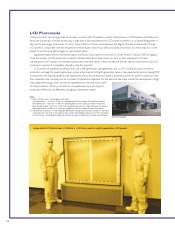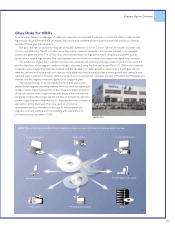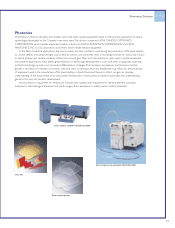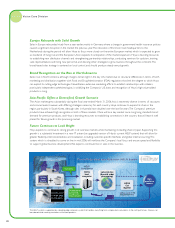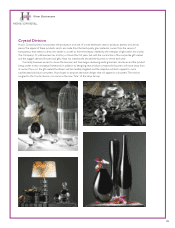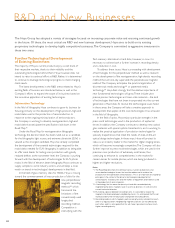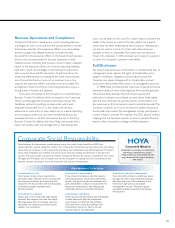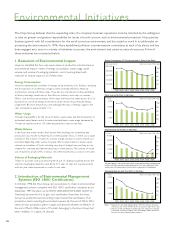Pentax 2006 Annual Report Download - page 27
Download and view the complete annual report
Please find page 27 of the 2006 Pentax annual report below. You can navigate through the pages in the report by either clicking on the pages listed below, or by using the keyword search tool below to find specific information within the annual report.
R&D and New Businesses
The Hoya Group has adopted a variety of strategies focused on increasing corporate value and ensuring continued growth
in the future. Of these, the most critical are R&D and new business development. Hoya aims to build on its existing
proprietary technologies to develop highly competitive businesses. The Company is committed to aggressive investment in
these two areas.
Further Technological Development
of Existing Businesses
The majority of Hoya’s current products enjoy a solid share of
their respective markets, thanks to their reliability and the
outstanding technologies behind them. Hoya, however, does not
intend to relax its continual effort at R&D. Rather, it is determined
to continue to leverage technological progress to meet changing
client needs.
The latest developments in the R&D arena related to Hoya’s
existing fields of business are introduced below, as well as the
Company’s efforts to expand the scope of its business based on
the innovative application of existing technologies.
Information Technology
In the field of lithography, Hoya continues to grow its business by
focusing primarily on the development of high-precision, high-end
mask blanks used in the production of semiconductors. In
response to the ongoing miniaturization of semiconductors,
the Company is working to develop next-generation, high-end
mask blank that anticipate the specifications laid down in the
Road Map.*1
Under the Road Map for next-generation lithography
technology, the electron beam has been ruled out as a candidate
for the lithographic light source, and extreme ultraviolet (EUV) is
viewed as the strongest candidate. Hoya has already completed
the development of the essential technologies required for the
mask blanks needed for EUV lithography. In addition to being able
to offer mask blanks for testing mass production with greatly
reduced defects at the nanometer level, the Company is pushing
forward with the development of technologies for EUV photo
masks. In the field of electron beam lithography, Hoya continues to
supply samples to some industry sectors, and will keep a close
watch on trends in technological developments in that field.
In the field of glass memory disks for HDDs, Hoya is moving
toward the commencement of mass production of disks for the
new perpendicular
magnetic recording
method,*2 which
transcends the
limitations of the
conventionally used
longitudinal
recording method.
Competition is
intensifying with the
flash memory alternative to hard disks, however, so now it is
necessary to achieve both a further increase in recording density
and a reduction in cost.
To address these issues, Hoya is proceeding with development
of technologies for the perpendicular method as well as research
on the development of the next-generation, high-density recording
method that will one-day supersede the perpendicular magnetic
method. The Company anticipates the practical application of
discrete track media technology*3 or patterned media
technology.*4 Hoya feels strongly that the relative importance of
new fundamental technologies will grow. These include ultra-
precise process technologies and nano-scale materials—the kind
of technologies that have not been incorporated into the current
generation of hard disks. To resolve the technological issues faced
in these areas, the Company will take a creative approach to
development that applies all the core technologies it has amassed
in the field of lithography.
In the field of optics, Hoya enjoys particular strengths in the
press mold technologies used in the production of aspherical
lenses. In addition, the Company continues to develop new optical
glass materials with special optical characteristics, and is working to
realize the practical application of production technologies for
specially shaped lenses that meet the needs of state-of-the-art
optical design technologies. In these ways, Hoya will protect its
status as an industry leader in the market for digital imaging lenses,
which will become increasingly competitive. The Company will also
further improve its press mold technologies, which are used in the
precision mass production of extremely small lenses, thus
continuing to enhance its competitiveness in the market for
camera lenses for mobile phones, which are being produced in
higher and higher resolutions.
Notes:
*1. The Road Map describes the setting of various numerical objectives and
associated technological issues that must be addressed to achieve the
production of next-generation semiconductors. This is an important set of guiding
principles in the context of the drive for technological development of
semiconductor manufacturers and the makers of equipment and materials used
in the production of semiconductors.
*2. A technology that increases the density of hard disk recorded data by
magnetizing the disk’s magnetic layer in a vertical direction, in contrast to the
current horizontal direction.
*3. By making a groove between recording tracks, it is possible to reduce the
magnetic interference between neighboring tracks. It is anticipated that this will
make possible further miniaturization and greater recording density.
*4. Recording media in which magnetic particles are physically isolated from each
other in a regular pattern. Neighboring magnetic particles are not affected by
each other, and it is anticipated that this will make it possible to achieve much
higher recording density.


